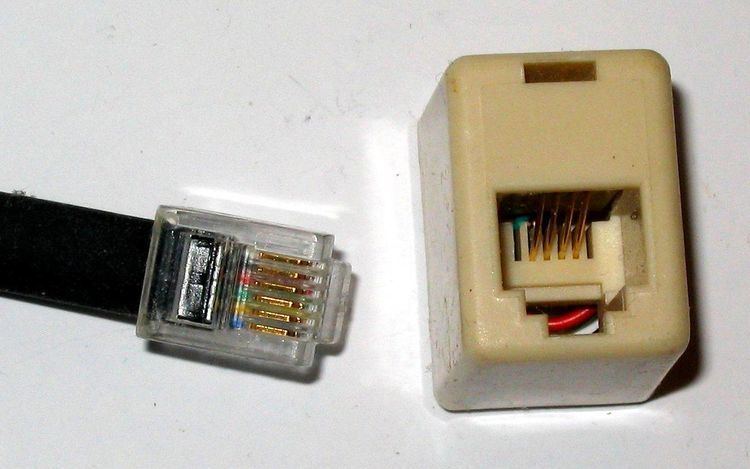 | ||
A telephone plug is a type of connector used to connect a telephone set to the telephone wiring inside a building, establishing a connection to a telephone network. It is inserted into its counterpart, a telephone jack, commonly affixed to a wall or baseboard. The standard for telephone plugs varies from country to country, though the RJ11 modular connector has become by far the most common.
Contents
- History
- Connections
- Wiring
- Compatibility
- Modular connectors
- Other connectors
- International standards
- National standards
- Legacy
- References
A connection standard, such as RJ11, specifies not only the physical aspects of an electrical connector, but also the pinout, i.e. the assignment or function of each contact. Modular connectors are specified for the registered jack (RJ) series of connectors, as well as for Ethernet and other connectors, such as 4P4C (4 position, 4 contacts) modular connectors, the de facto standard on handset cords, often improperly referred to as RJ connectors.
History
Historically telephones were typically owned by the telephone company and were usually permanently wired to the telephone line. However, for many installations it was necessary or convenient to provide portable telephone sets that could be moved to a different location within the customer's premises. For this purpose telephone companies developed jacks and plugs with a varying number of contacts. Before ca. 1930, concentric connectors with three contacts were sufficient, but the upgrade of telephone sets to anti-sidetone circuitry required four conductors between the desk set and the subscriber set. For this purpose, Bell System engineers developed a cube-shaped four-prong plug (type No. 238) with uneven prong spacings to avoid improper insertion into the jack (type No. 404). This jack and plug combination later became the standard line connection for portable telephone sets.
This type was redesigned as a round version (No. 505A) in the mid 1960s. The four-prong connector type was superseded by the modular connector in the 1970s.
Many countries initially used different specifications for connectors, and some national connector types remain in service, but few are used for new installations for which modular connector types are prescribed.
Connections
The installation of a conventional wired telephone set has four connection points, each of which may be hardwired, but more often use a plug and socket:
Some of these may be absent: Wired telephones may not have a separate base and handset. The defining characteristic of wireless telephones is that they do not have a handset cord, and the defining characteristic of mobile telephones is that they do not have a phone cord.
Wiring
A standard specifies both a physical connector and how it is wired. Sometimes the same connector is used by different countries but wired in different ways.
For example, telephone cables in the UK typically have a BS 6312 (UK standard) plug at the wall end and a 6P4C or 6P2C modular connector at the telephone end: this latter may be wired as per the RJ11 standard (with pins 3 and 4), or it may be wired with pins 2 and 5, as a straight through cable from the BT plug (which uses pins 2 and 5 for the line, unlike RJ11, which uses pins 3 and 4). Thus cables are not in general compatible between different phones, as the phone base may have a socket with pins 2 and 5 (requiring a straight through cable), or have an RJ11 socket (requiring a crossover cable).
When modular connectors are used, the latch release of the connector should be on the ridge side of flat phone wire in order to maintain polarity.
Though four wires are typically used in U.S. phone cabling, only two are necessary for telecommunication. In the event that a second line is needed, the other two are used. They are also sometimes used to provide power for telephone dial lamps (6 volts AC, as in the Princess phone), or other features.
Compatibility
Different telephone connections are generally compatible with the use of an adapter: the physical connector and its wiring is the primary incompatibility.
See: gallery of telephone adapters.
Modular connectors
Other connectors
International standards
National standards
Polish WT-4 plug is adopted in Russia as ШТР-IV and has four metal pins and additional fourth dielectric pin. Corresponding socket comes in two variants. GTN-4 socket (РТШ-IV in Russia) provides 4 pin connection (in most cases two rightmost pins are used for connecting a single line). GTNC-4 (РТШК-IV) has an additional circuit: the 5th plastic pin of inserted plug disconnects 1 μF capacitor that otherwise close the circuit of the telephone line while plug is not inserted into socket. This feature allows testing the line when the phone is not plugged in. The usage of capacitor is mostly obsolete and GTN-4 sockets produced later reuse capacitor compartment for additional RJ11 socket.
Legacy
This list covers only single line telephone plugs commonly used in homes and other small installations; there are 44 different variations of plugs, including an Israeli version of BS6312 with different internal wiring of the pins, plus hard wiring to a junction box with no adapter. Special telephone sets use a variety of special plugs, for example micro ribbon for key telephone systems.
